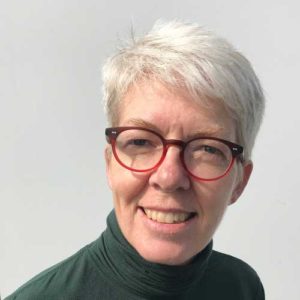Canadian Iyengar Yoga Conference with BKS Iyengar
by Christine Rondeau
The following is the complete speech delivered by Shirley Daventry-French at the opening of the 1990 Canadian Iyengar Yoga Conference at the University of Alberta in Edmonton, July 2-6 1990. The Editorial Board at the time decided to publish it in full in their Spring 1991 newsletter. They pointed out that that their readers would find a most informative account of the beginnings of Iyengar Yoga in Canada from a uniquely Western Canadian perspective! I thoroughly enjoyed discovering this old newsletter and thought I would reprint it here. Enjoy!
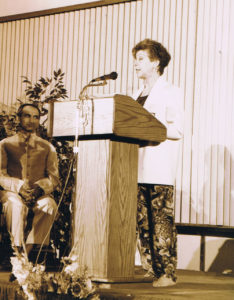 Revered Guruji, Honoured Guests, Fellow Yoga students, I have been asked to speak to you tonight about the evolution of Iyengar Yoga in Canada.
Revered Guruji, Honoured Guests, Fellow Yoga students, I have been asked to speak to you tonight about the evolution of Iyengar Yoga in Canada.
The weekend before I was to leave for San Diego and on to Edmonton, my three children arrived from out-of-town, each accompanied by a friend or spouse. Six extra people! Someone would have to sleep in my office restricting access to the computer on which I depend a great deal. Yes, another attachment!
I was looking forward to a “free” weekend to organize for my journey. “Free” meant Saturday and Sunday because there was a yoga centre executive meeting on the Friday evening.
My children are young adults leading busy, productive lives of their own. It’s difficult these days for the whole family to come together, and when it happens it’s a precious time. But their return does require some adaptation. Since they left home, one of their bedrooms has become my office, another Derek’s study and the third a TV room. Their playroom is now a yoga studio. Things have changed.
I love my children and love to see them – and even though their timing is not impeccable – when they want to come home, I don’t turn them away. There is a saying that home is a place where, when you want to go there, they have to take you in. This is what it means to have a family. This is what it means to follow the path of the householder.
I am not a renunciate who practises yoga in a cave or an ashram. I am here in the marketplace, and have to adapt, adjust, accommodate frequently!
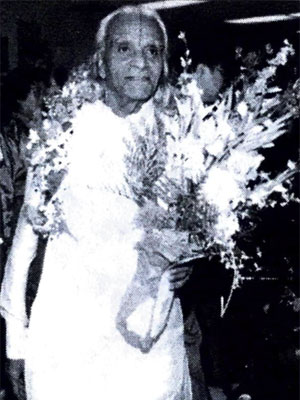
While my biological family gathered for the weekend, I prepared to go to the yoga centre meeting and interact with another family – the Victoria Yoga Centre.
We were holding a long overdue executive meeting – overdue because of the difficulty we have in getting together. It’s hard to find a time which is convenient for everyone – in fact, it’s impossible. Yet we manage to keep going, and in some cases have maintained our connection for nearly twenty years. The thread of the work holds us together. We are committed to the work and to each other – even though sometimes we get on each others nerve’s – just like any normal family!
This conference is a celebration of the Iyengar Yoga family. A coming together and perhaps coming of age of the Canadian branch of this family.
Ten regional centres and many individuals have been involved in the organization of this conference, working together, freely offering their expertise, talents, financial support and, most precious of all, their time.
To accomplish all that had to be done we had to develop trust and respect. Respect for each other’s choices. Trust that all who committed to this project in the first place would fulfil their commitments.
The Victoria Yoga family and the Iyengar Yoga family are adopted families.
When we accept him as a guide or mentor, Guruji adopts us – often he calls us his children. We are his spiritual children – in the beginning spiritual babies.
How did it happen that across this young, cold, vast, empty, predominantly Christian land so many people made a connection and a commitment to a Hindu Brahmin teacher from a hot, dusty, densely populated, ancient country half a world away?
We had sent out a signal, he answered it. The Guru does not seek us, it is up to us to seek him – which does not always happen at a conscious level. Most of us have tales to tell of the strange coincidences which brought us to Yoga and to our teacher, and you can read about some of these in the conference magazine.
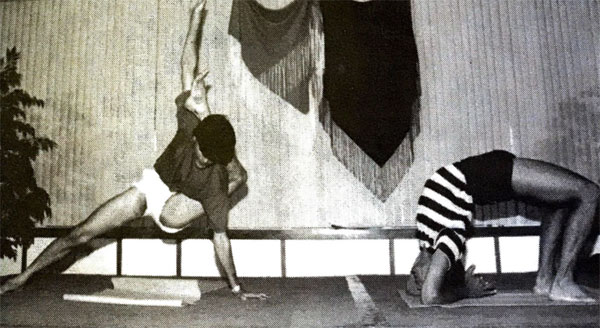
We owe a great debt to those who give us birth – who protect us until we are able to take care of ourselves, nurture, support and sustain us while we develop strength and maturity, who want the best for us, who encourage us to seek the utmost from life and develop our God given talents.
Guruji has given us the opportunity to live a spiritual life and fulfil our destiny, if we make the effort – what a precious gift!
In a book on Zen I once read a statement that if we carried our parents around on our backs for the rest of their lives we could still not repay them for giving us this gift of life.
How can we ever repay Guruji for our spiritual birth? He has given us the answer many times – in words, in writing and, most of all, by his example.
We can repay him by practising, by learning, by sharing, by putting aside pride, arrogance, competitiveness and working together as equal members of a family. This he has asked of us on many occasions, reminding us that with his own six children naturally they had different needs at different times so the amount of attention he gave them varied according to these needs and according to the individual circumstances, but in his heart, there was no difference – he loved them all equally.
The Canadian branch of the Iyengar Yoga family is loosely organized. We are allowing the structure to develop slowly to reflect and facilitate the work rather than setting up an organization first and then trying to fit ourselves into it – being boxed in. We are striving for something flexible, fluid, which will serve ourselves, our souls, our communities, our teacher. Something that will enhance growth. Otherwise what would be its purpose?
This lack of a formal organization has not prevented us from becoming close-knit and committed to each other or from propagating the work. You have only to read the conference magazine and look through the teachers’ directory to see evidence of this.
Certainly working together on the conference has developed a wonderful bonhomie, and despite learning a lot about each other’s prejudices and idiosyncrasies, there is a great deal of affection and acceptance. We have come to appreciate each other’s humanity, and, as Patañjali tells us in his yoga sutras, first we have to become fully human before we are ready for spiritual life.
It’s a pleasure to be in such company as is gathered here tonight.
I am reminded of the scene in Shakespeare’s Henry V before the Battle of Agincourt, when Henry tells his frightened soldiers that when it is all over “gentlemen – in England now a bed shall think themselves accursed they were not here“. Stirring words, a little strong perhaps, but reflecting my feelings that this is an opportunity of a lifetime!
We are fewer here than we had hoped, but in that same play, Henry V, and in that same speech Shakespeare (not Churchill) wrote the words: “We few, we happy few, we band of brothers.” (Shakespeare was a creature of his time – sisters did not enter into it! In those days even the female parts in his plays were performed by men.) Those of us who are here with Guruji at this special time will always share a bond just as those of us who have worked together in India have a special bond.
It was at the 1987 convention in Boston that we held our first Canadian teachers’ meeting. Later, we met with Guruji, and one of the things he told us was that Canadians are like Indians. He was referring to our lack of certificates and desire to keep it this way, but perhaps there are other similarities in the way we function. Guruji said that his wish and his request to us was that we come together like a family, forgetting our differences, and this is what we have done.
Each region has its own way of doing things. There are differences but there are also many similarities. The way we work may vary, but we all recognize the importance of doing this work – finding a balance between our own personal practice and the propagation of Yoga.
In the conference magazine we have a section entitled The Teacher, The Teaching, The Work. I believe – and have seen it written down in the apprenticeship and teacher training outlines from all across the country – that to become a well-rounded teacher of Iyengar Yoga requires an involvement in the work of the local community. It is not enough to simply “do your own thing”.
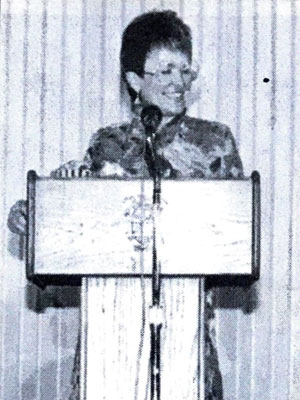
The core group who organized the conference comes from those individuals who are already working and responsible in their own communities.
On Sundays, in our local newspaper, there is a regular column written by a retired United Church minister called Perspectives. I find his writing very yogic. On one occasion he wrote a classic piece – pointing out that it is impossible to live a morally creative life without compromises because the choices we have to make are rarely between good and evil, right and wrong. Sometimes the choice is between two good possibilities, which is not always easy, and sometimes between two undesirable situations forcing us to judge which is the lesser of two evils. Most choices are inextricably mixed. Refusal to make a decision is in itself a decision, one which sometimes engenders a sense of self- righteousness.
Those who take action are often criticized by those who don’t or won’t. The Rev. Davidson maintains that you cannot live a morally responsible life without making compromises and quotes the poet Archibald MacLeish who observed that “the world is divided into two kinds of people: the pure and the responsible.”
In most circles, and yoga is no exception, there are those who sit on the sidelines and make disparaging remarks about how things are being done – when you are not involved in the decision making process it’s very easy to take the moral high ground and criticize the decisions which have been taken and those who made them, as it is with hindsight.
Hindsight can be helpful, however, when it helps you to improve the next time. If – dare I say it – we were to do the whole thing again, certainly some things would be done differently. Hopefully we’ve learned something. All the various groups and many individuals were consulted over major decisions, which necessitated a lot of long distance telephone calls – one of the main beneficiaries from all this was the telephone company. Sometimes a consensus was impossible and the minority had to surrender to the will – of the majority – this is the democratic process. There have been plenty of opportunities to practise vairagya.
On the path of yoga, we find some strange companions.
Here we have this disparate group of people living, hundreds – and in many cases, thousands of miles away from each other organizing a major event.
At last year’s teachers’ meeting, we learned that Mr. Iyengar was willing to come to Canada after the San Diego convention, for a short time and to one place. Obviously we must be willing to travel to that place to be with him. It was decided that Edmonton would be that one place, and the event would be planned and organized nationally. And here we are, together in the presence of our teacher!
One of Canada’s great assets is the variety of its scenery and the diversity of its people. This is reflected in the yoga community. Some groups are highly organized, structured, computerized, yoga is their business. Others prefer to “go with the flow” are mellow and laid back – in some groups everyone has to have their say. In others, decisions are made by a few without consulting the many. Some groups consist of only “a few”.
Fortunately all speak the common language of Yoga, and so we are able to communicate.
Canadians struggle with issues around identity and the question often arises: Who are we, and how did this odd group of people become a country?
Yogis also struggle with the problem of identification, and in my own local group and the broader national connection, again the question arises: How did this odd group of people come together? What does it mean? What purpose does it serve?
The thread which connects us is of course, our teacher and his teaching. Even if you have not had and never have a personal connection with Mr. Iyengar but are following his teaching, that link is there. Once a Victoria teacher, a student of mine, who hadn’t been to India was questioning her right to call herself an Iyengar teacher. She said to me “I haven’t worked with Mr. Iyengar, I work with you — really I am a Shirley Daventry French teacher!” I quickly dispelled this notion by saying that if she is following my teaching as she understands it, and I am following Mr. Iyengar’s teaching as I understand it, then the link is there – she is an Iyengar Yoga teacher. In the yogic tradition the teachings are passed from generation to generation through a line of teachers. It is a long lasting tradition reminding us that the teachings are not ours but are universal.
Throughout Canada from St. John’s, Newfoundland to Victoria, British Columbia, Guruji’s work has united us in the Light. This took a little time.
In the Conference magazine the evolution of Iyengar Yoga in Canada is described at some length, so I won’t go into all the details here – do read it, it’s fascinating.
In the mid 7O’s there was a phenomenon, which Carl Jung called synchronicity, when Iyengar Yoga started to manifest all over the land. Beams of light from Pune penetrated our borders from all directions – north, south, east and west, and having alighted sparked off other beams which criss-crossed the country until Iyengar Yoga was being practised in all ten provinces, most major cities and many remote communities. We were ready and receptive. There was such an eagerness and thirst for the refinement and creative brilliance of Mr. Iyengar’s work.
At first, some of the entrenched yoga teachers who didn’t like Iyengar Yoga resisted and tried to stop the emergence of this work, causing difficulties in some areas. But the seed was too robust, the soil too fertile – it could not be prevented from germinating and bearing fruit.
Yoga teaches us that our evolution cannot be stopped – although God knows sometimes we try. However, it can be inhibited and slowed down – sometimes almost to a standstill. But even when our sloth causes us to backslide and lose ground, sooner or later, in this life or the next, we must pick ourselves up and go on again.
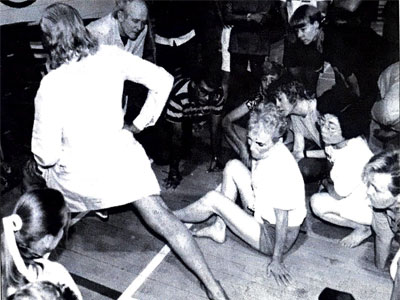
Bruce Carruthers watches his teacher closely.
In the late 60’s, when interest in yoga was awakening in the western world, the yoga most widely known and available in Canada was Sivananda Yoga. When the Canadian teachers met in Boston we went around the room and introduced ourselves saying a few words about our beginnings in yoga, and learned that many people had started with Sivananda Yoga, which is not surprising because two of Swami Sivananda’s disciples had established ashrams in Canada – Swami Vishnu Devananda in Quebec and Swami Radha in B.C. They travelled and taught across the country.
At this time there were no classes available in Iyengar Yoga but students everywhere had Mr. Iyengar’s book Light on Yoga.
Later we were to learn that when Swami Sivananda saw the work of Mr. Iyengar he remarked it was as if he were seeing the rebirth of Matsyendranath, the founder of asanas, and honoured him with the title of “Yogi Raja”.
The links in the chain were being forged.
Across the country, those interested in yoga were learning about the Iyengar approach to Yoga where and when they could. The ground was being prepared for personal contact with Mr. Iyengar. First a few, then a few more, then many became Guruji’s students.
The first Canadians who went to India went with U.S. groups who generously offered some places to Canadians.
Then in 1979 Canadians filled their own intensive which was organized by Maureen and Bruce Carruthers with students coming from Vancouver, Victoria, Calgary and Edmonton.
In 1982 there was another intensive from western Canada organized by Ingelise Nherlan, and in 1985 I took a group which included students from eastern and central Canada – from Montreal, Toronto, Ottawa, Winnipeg – as well as from the West.
The most recent Canadian intensive was in 1988, the year of Guruji’s 70th birthday celebrations when Liz Mcleod led a group which included students from St. John’s, Newfoundland to Victoria B.C. and all major centres in between. The coast to coast connection was complete.
In the 60’s Guruji’s book Light on Yoga planted a seed. In mid 70’s the seed sprouted in Canada. In the 80’s it multiplied. Now, at the start of the 90’s, it is auspicious that we are holding our first Canadian conference and Guruji is with us.
One of the highlights of the evolution of Iyengar Yoga in our country was Guruji’s first visit here in 1984.
After the San Francisco Convention he came first to Vancouver, from there by private boat to Victoria, and on to Edmonton to complete his visit. Many Canadians escorted him on the plane from San Francisco to Vancouver and I was fortunate to be one of them. When we landed in Vancouver, Guruji announced that since his native tongue was Kannada, he was a true Canadian. Kannada is the language of the Indian province of Karnataka where Guruji was born.
Our Canadian association has evolved slowly, steadily and informally. Nothing has been written down, registered, formalized. After all, Canada gets into terrible trouble when it tries to write things down, as we all know from the problems over the Constitution and Meech Lake Accord!
I am an immigrant to Canada. When I first came here from my native England I landed in Quebec and travelled by train from east to west to try and get a sense of this vast country. I have been fortunate , through Yoga I have travelled to most parts of Canada and come to appreciate the variety of the land, the warmth and steadfastness of its people.
Canada is a great country to live in. Here I have never felt any pressure to be anything other than myself. There is space to grow. Change happens slowly – after all the the French and English still have not settled their grievances from 1759!
Tenacity does have its bad points when it means holding on to grudges or maladaptive ways of life, but it is a tremendous asset in yoga. Here in Canada we have a harsh climate that forces us to endure. Our national anthem extolls us to stand on guard – and Tadasana is a great help!
Canadians have a natural reserve and reticence which encourages contemplation. They are also taciturn, soft spoken – reluctant to speak up and speak out. Look at the announcers on the CBC news: I think they have a special training school where they learn how to speak without moving their mouths (it’s not only the British who have stiff upper lips).
Perhaps sometimes we are too slow to speak up on our own behalf, but this reserve and reluctance to interfere with others has also contributed to the qualities of fairness and dispassion which have enhanced our reputation as peacekeepers.
Canada is a great country to live in and a great place to practise Yoga.
Earlier I mentioned that we had our first teachers’ meeting in Boston during the 1987 Convention. Many Canadians were invited to teach there, and three years earlier we had also been invited to the San Francisco convention. Our neighbours to the south have a great deal of energy and we owe them a lot for bringing Guruji to this continent on three different occasions in the last decade. We have benefited from their initiative and must not forget this.
We are a young nation, 123 years old, evolving in our own way. Our population is sparse. We have 25 million people spread throughout the second biggest country in the world. Travel and communication is costly and difficult – especially in winter, but not impossible. There’s a saying that “Nothing is impossible”. I don’t know about that, but I do know that we can accomplish a lot if we put our minds and hearts together and direct our energy towards a common goal.
At the teachers’ meeting in Boston, one thing we were sure about was that it was important to meet again. The following year seventeen of us spent a week at a rustic lodge by a lake in the countryside between Montreal and Ottawa, organized by the Montreal group. Several times on the telephone, Marie-Andrée Morin had mentioned that the lodge was very rustic. She repeated this so many times I began to see it as some sort of warning. When I arrived in Montreal, she repeated: “It is very rustic, I hope it will be alright.” The lodge was indeed rustic, but it was in a beautiful spot and we had a wonderful time. We shared and learned a lot and agreed that this should become an annual event, perhaps alternating between the East and the West – like the Grey Cup. Our next meeting took place last year here in Edmonton when a larger group of twenty eight teachers met at the University of Alberta and made the decision to plan this year’s meeting around Guruji’s visit.
Here we are – and here he is!
Welcome Guruji. Bienvenue au Canada. We are deeply honoured to have you here with us in our own country once again. Welcome also to those who are travelling with Guruji from India and France. We hope you enjoy your time with us.
To all of you here tonight, I extend an invitation, to become involved and take part in the process of building a national community which will serve Guruji and all of his students in Canada – one which will bring out the best in all of us and facilitate our journey on the path of Yoga.
What does it means to come together like this? It means sacrifice, effort, surrender, food for the soul.
Recently I read an article by an Englishman who had just returned from his first trip to the Institute in Pune. He wrote about the concerns he had had before going about not being able to perform well enough during the Intensive, and his discovery that he was not there to perform but to learn.
I believe that this is the true purpose of our being here together – to learn, from Guruji and from each other. I hope this conference will be a worthwhile experience for all of you, and that you will have plenty of opportunities to learn about yoga, about life, its meaning and purpose, and about your higher self!
Om Namah Sivaya.
